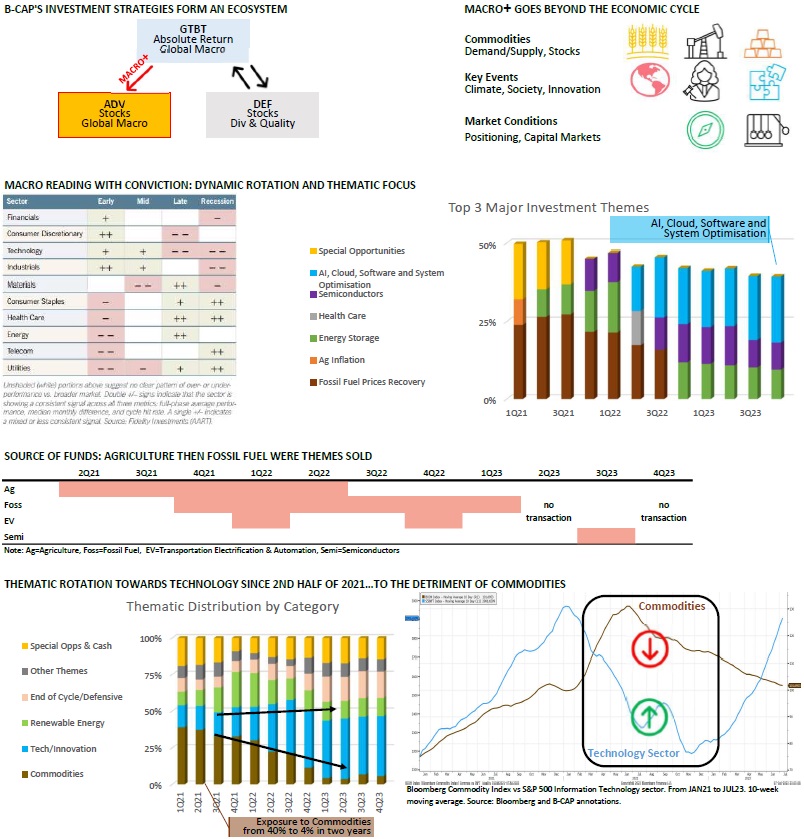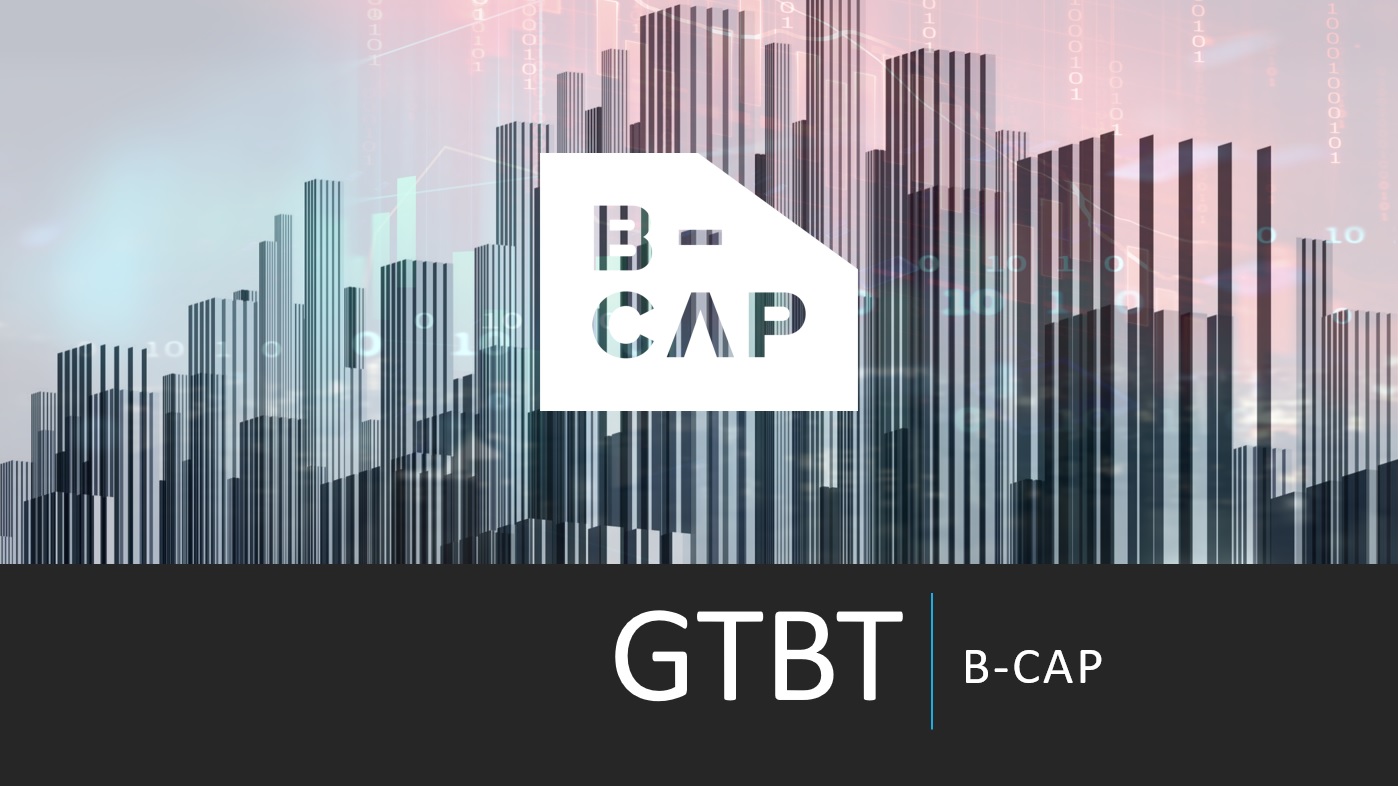PORTFOLIO MANAGEMENT /
STRATEGIESB-CAP
COMMON SHARES

ADVENTURER
Macro+ Thematic Investing
B-CAP’s Adventurer strategy is meticulously crafted to achieve long-term capital appreciation through direct investments in the share capital of carefully selected publicly traded companies, identified by our seasoned manager.
Our portfolio construction follows a comprehensive approach that blends dynamic exposure to opportune themes derived from a macroeconomic (top-down) framework with a meticulous stock selection process involving a mix of quantitative fundamental investigation and qualitative analysis. We take pride in our management style that places a strong emphasis on identifying issuers with a powerful competitive advantage in terms of innovation and disruption, aligning with our insightful macro analysis.
Setting us apart from many other products in the industry, the Adventurer model offers a remarkable degree of flexibility. This flexibility extends to sector concentration, allowing for adjustments with a maximum limit of 40% per sector. Moreover, the model accommodates investments in companies of various sizes, with a maximum limit of 25% for companies with a market capitalization below $500 million. To ensure a strategic approach, the model adheres to a stock rotation strategy with an investment horizon spanning 2-5 years. These distinguishing features, coupled with our ability to navigate unconventional opportunities with agility, establish the Adventurer strategy as a unique offering in comparison to several other equity mandates available in the market.

MISSION: ADJUSTING THE THEMATIC TILT ACCORDING TO THE MACROECONOMIC CONDITIONS (PRESENT AND ANTICIPATED)
The Adventurer strategy adapts its sector and factor exposure according to macroeconomic conditions. Without being an exact science, anticipating the economic cycle is central to the manager’s decision-making: economic acceleration or deceleration, above or below the inflation acceleration threshold, financial conditions, propensity to consume, investments, inventories, financial leverage, money supply, etc. Empirical analysis of the historical performance of risky assets reveals a significant relationship with the stage of the current cycle, from ‘recovery’ to ‘recession’. The portfolio manager plays here, in the foreground, a role of market strategist, expressed through the selection of investment themes (macro, factorial, fundamental attributes, industry) and common shares of companies associated to them.

Adventurer / Management Reports
2023 Quarterly Overview
2022 Quarterly Overview
2021 Quarterly Overview

DEFENCE
Sustainable Dividend Growth
B-CAP’s Defence strategy is designed to achieve long-term capital appreciation by investing directly in the equity of public companies carefully selected by the manager.
The portfolio construction primarily relies on a bottom-up approach, wherein the manager applies quantitative filters to identify suitable large-cap listed companies. The management style places a strong emphasis on the sustainability of dividend growth. To ensure this sustainability, the manager considers various factors such as historical and projected growth in revenue per share, profit margins, free cash flow, return on equity, and maintaining a reasonable debt level. Additionally, the manager assigns significant importance to identifying companies with a strong competitive advantage within their respective industries.
The Defence model adopts a long-term investment horizon of 5-10 years and focuses on stocks issued by large companies (minimum of $1 billion, with the majority exceeding $5B) that exhibit high potential for dividend growth. This approach is implemented without compromising on quality, taking into account factors such as creditworthiness, reputation, economic moat, and consideration of Environmental, Social, and Governance (ESG) aspects.

MISSION: PROMOTING SUSTAINABLE DIVIDEND GROWTH
The manager meticulously screens an expansive universe of securities, focusing on companies that exhibit robust financial fundamentals. This approach enables the anticipation of high growth rates in cash flows and a substantial return of capital to shareholders through dividends and share buybacks. Special emphasis is placed on evaluating the issuer’s financial track record, including its resilience across economic cycles, particularly during periods of economic downturn. Key metrics such as sales per share, margins, financial leverage, and more are carefully scrutinized to ensure a comprehensive assessment of the issuer’s financial history.

ROBUST QUALITATIVE ATTRIBUTES
The manager demonstrates a strong inclination towards companies operating within oligopolistic industries, characterized by higher barriers to entry and operating margins. The sustainable growth of dividends primarily hinges on the resilience of the business model, necessitating an evaluation that goes beyond numerical analysis. This evaluation involves an in-depth examination of the competitive landscape, the quality of the product being offered, its perceived necessity among consumers, the company’s ability to manage pricing and cost structures, and various other factors. Furthermore, Environmental, Social, and Governance (ESG) factors are duly considered as they contribute to elucidating the sustainability of both the company and its brands.
The Defence strategy (DEF) exhibits robust ESG credentials and demonstrates a superior Capital Allocation score, surpassing the MSCI World High Dividend index, its benchmark.
Defence/ Management Reports
2023 Quarterly Overview
2022 Quarterly Overview
2021 Quarterly Overview
Defence/ Research Reports

GOOD TIMES BAD TIMES (GTBT)
Absolute Return, Directional Bias
The name of the strategy ‘Good Times Bad Times’ (GTBT) is linked to its investment mandate: TO GENERATE POSITIVE 12-MONTH ABSOLUTE RETURN IN ANY MARKET ENVIRONMENT
GTBT in brief:
- Long / Short
- Opportunistic
- Unconstrained
- Macro Framework
- Adaptable Multi-Strategy
- Global, Across Major Asset Classes
The main determinants of the decision process are
1) Position in the economic cycle
2) Factors (ref ‘factor investing’)
3) Quantitative and qualitative data on industries
4) Street estimates vs potential
5) Fear vs greed
6) Market positioning
7) Corporate activity
8) Technical Analysis
Generally speaking, the manager invests where estimates lag rising/healthy fundamentals, with an interest in overlooked themes/ underowned areas.
B-CAP’s flagship strategy invests in listed liquid financial instruments, via direct exposure or options strategies. The expected volatility is that of the MSCI World (or less). The expected correlation with primary benchmarks is intended to be low (or negative).
The GTBT strategy stands out mainly through its unconventional approach to investment: it is exposed to various promising themes (‘top-down’), it goes off the beaten track, and it has a variable net exposure degree to the market.
01. Focus on themes
The backdrop is a reading of economic and corporate activity, paired with the context of risk taking (central bank actions, investor sentiment, financial conditions, etc.). The methodology is thus mainly top-down. The manager draws up a list of themes that he considers to be promising, which will be investigated further, often willingfully left aside by a strong optimism already carried by a large number of participants. The intention is indeed to avoid dense crowds, especially in small venues…
The themes chosen, often broken down into a few individual but related positions, may target industries with high growth potential, investment factors, interest rate movements, rmean reversion, inflationary pressures and much more.
02. off the beaten track
The analysis of themes often leads to companies unknown to most of the investment community, often little or not covered by research departments (sell-side). GTBT is not afraid to venture off the beaten track and browse through information in order to find interesting candidates. Each company is researched, sometimes contacted directly, always cataloged.
The choice of financial instruments is also often out of the ordinary. GTBT regularly updates its own analysis, valuation and grading systems for warrants, convertible debentures, and preferred shares. The manager also makes extensive use of the liquid market for listed options.
That said, GTBT excludes certain types of risk, such as private markets and IPOs.
03. Variable net exposure
GTBT always holds a few active ‘short’ positions, which together may or may not represent an influential weight on the overall strategy. The general strategy analysis framework (macroeconomics, market positioning and technical analysis) provides a general indication of the potential for short to medium term correction. A high degree of investor and ‘Sell Side’ confidence, together with the risk for a slowdown that is poorly or not integrated into economic expectations, would be an opportunity to call upon defence…
The strategy uses several methods in order to protect the capital and even see it grow, in a context of down markets: buying put options, ‘bear call spreads’ option strategies, reviewing the weights allocated to the various factors, lowering the weight of warrants, interest rate / credit-oriented strategies, etc.
GTBT / Public Summary Presentation
Latest Quarterly Introduction
If you are an accredited investor and are interested in learning more about this strategy (historical returns, volatility, manager’s comments, summary positioning, etc.), please contact us.
